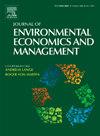Adaptation and mitigation of pollution: Evidence from air quality warnings
IF 5.9
3区 经济学
Q1 BUSINESS
Journal of Environmental Economics and Management
Pub Date : 2025-08-05
DOI:10.1016/j.jeem.2025.103215
引用次数: 0
Abstract
Many cities have adopted air quality alert systems to reduce the health risks from severe pollution episodes, pairing public messaging with temporary restrictions on vehicle and industrial activity. Despite their widespread implementation, evidence on their effectiveness remains mixed, in part because of data limitations and a focus on traffic-only or voluntary measures. This paper evaluates Mexico City’s air quality alert program using a fuzzy regression discontinuity design that exploits a preset ozone threshold for policy activation. I find that alerts lead to significant improvements in ozone and sulfur dioxide concentrations and sizable reductions in emergency department visits for respiratory (56 % decrease) and cardiovascular conditions (50 % decrease). The effects on transport-related pollutants are smaller and time-dependent, consistent with the alerts mitigating vehicle emissions more slowly. To assess mechanisms, I analyze information-seeking behavior, mobility data, and emissions inventories. The alerts increase online searches about air quality and the policy itself, but not about protective behaviors. Traffic volume falls and congestion improves, though public transit usage does not increase. Finally, I show that the pollution reductions are largest near restricted industrial facilities, which suggests that industrial curbs play a central role in policy effectiveness. These results can support the design of short-term environmental response policies in cities facing both mobile and stationary sources of pollution.
适应和减轻污染:来自空气质量预警的证据
许多城市采用了空气质量预警系统,将公众信息与临时限制车辆和工业活动相结合,以减少严重污染事件带来的健康风险。尽管这些措施得到了广泛实施,但关于其有效性的证据仍然好坏参半,部分原因是数据有限,而且只注重交通或自愿措施。本文使用模糊回归不连续设计评估墨西哥城的空气质量警报程序,该设计利用预设的臭氧阈值进行政策激活。我发现警报导致臭氧和二氧化硫浓度的显著改善,呼吸道疾病(减少56%)和心血管疾病(减少50%)的急诊就诊人数大幅减少。对交通相关污染物的影响较小,且依赖于时间,这与缓解车辆排放的警报速度较慢相一致。为了评估机制,我分析了信息寻求行为、移动数据和排放清单。警报增加了网上对空气质量和政策本身的搜索,但对保护行为的搜索却没有增加。交通量下降,拥堵状况改善,但公共交通的使用率没有增加。最后,我指出,在受限制的工业设施附近,污染减少幅度最大,这表明工业限制在政策有效性中起着核心作用。这些结果可以为面对流动和固定污染源的城市设计短期环境响应政策提供支持。
本文章由计算机程序翻译,如有差异,请以英文原文为准。
求助全文
约1分钟内获得全文
求助全文
来源期刊
CiteScore
8.00
自引率
4.30%
发文量
91
期刊介绍:
The Journal of Environmental Economics and Management publishes theoretical and empirical papers devoted to specific natural resources and environmental issues. For consideration, papers should (1) contain a substantial element embodying the linkage between economic systems and environmental and natural resources systems or (2) be of substantial importance in understanding the management and/or social control of the economy in its relations with the natural environment. Although the general orientation of the journal is toward economics, interdisciplinary papers by researchers in other fields of interest to resource and environmental economists will be welcomed.

 求助内容:
求助内容: 应助结果提醒方式:
应助结果提醒方式:


